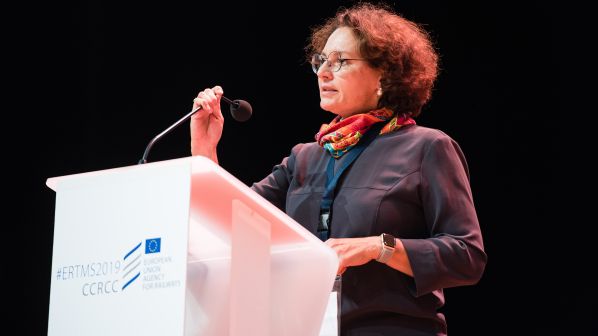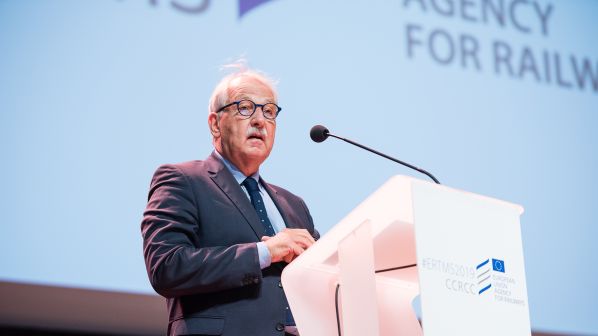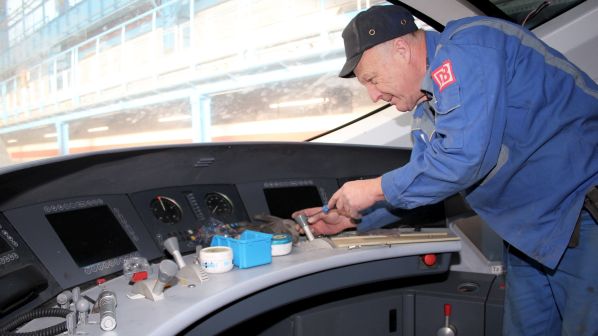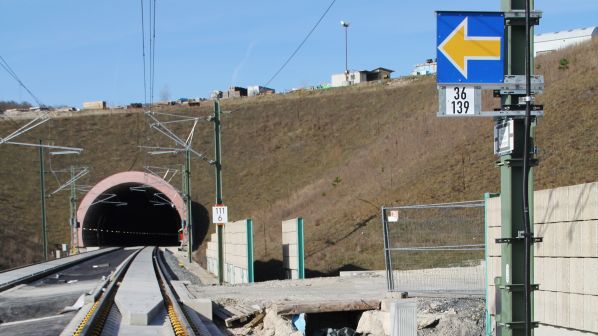SWEDEN is the latest European country to announce a delay to its ERTMS roll-out programme. National infrastructure manager Trafikverket says it wants to give train operators more time to withdraw old trains, equip existing trains with ERTMS and purchase new ERTMS-equipped trains. Trafikverket also cites the complexity of installing ERTMS at major stations and hubs and coordinating its work with neighbouring Danish infrastructure manager Banedanmark.
Unfortunately Sweden’s experience is all too common, and does not bode well for the European Union’s (EU) revised European Deployment Plan for ERTMS which was agreed in 2017. “We are already behind schedule,” says Ms Elisabeth Werner, director of land transport with DG Move, who was speaking at the European Agency for Railways’ (ERA) CCRCC 2019 ERTMS conference in Valenciennes in October. “Some 5700km have been delivered compared with a target of 7700km.”
The Deployment Plan really refers to the installation of ETCS, the signalling and train control element of ERTMS, as the roll-out of GSM-R, the telecommunications element, has been a great success and has been deployed on more than 140,000km in Europe.
“Nobody is questioning the rationale for ERTMS deployment anymore, it was not the case even a couple of years ago. Now, it is no longer a question of ‘if’ but rather ‘when and how’.”
Matthias Reute, European ERTMS coordinator
Mr Matthias Reute, who took over as European ERTMS coordinator in January 2019, says most of the delays do not exceed two to three years, and the majority of the pending lines are under construction. “Furthermore, in a number of cases the works have finished but the line is not in operation for various reasons,” Reute told delegates in Valenciennes.
“Nobody is questioning the rationale for ERTMS deployment anymore,” Reute says. “It was not the case even a couple of years ago. Now, it is no longer a question of ‘if’ but rather ‘when and how’.”
While this is real progress - ERTMS conferences used to be lively affairs with much heated debate between the protagonists and those vehemently opposed to the platform - there is still a lot of foot dragging and a range of attitudes to it in Europe, as Reute explains. “Several early movers for nationwide deployment delay it, which undermines the business case for retrofitting rolling stock,” Reute says. “Others are on track and intend to decommission class B systems but rolling stock in neighbouring countries is not ready. There are also ERTMS ghost lines, where lines are equipped but not used.
“It seems that some member states are deploying ERTMS just because it is required by Brussels but without the deeper conviction that it makes any sense or without having a vision of the ultimate objective. But they might be good pupils and even deploy ERTMS on the core network by 2030. Other member states are doing the absolute minimum and without a sudden policy change, there is no chance they will deploy ERTMS on the core network by 2030. Some member states realise the potential to deploy ERTMS nationwide and have announced ambitious plans. These countries realise that equipping just a corridor does not bring sufficient benefits.”
“ERTMS will only demonstrate its full value when it reaches a critical mass, when it reduces costs for infrastructure managers and when for operators it is a replacement system rather than an additional cost.”
Elisabeth Werner, director of land transport DG Move
According to Werner, fully executed national deployment plans are vitally important to delivering the wider deployment of ERTMS, but she says national plans must take note of the European and corridor dimensions in their planning and execution. “Luxembourg, Belgium, Denmark and Sweden are all in the process of moving to full network deployment,” Werner says. “Germany and Italy have ambitious plans. Alongside the full network deployment already achieved in Switzerland, this means that significant networks and international corridors will be equipped in the coming years.

“ERTMS will only demonstrate its full value when it reaches a critical mass, when it reduces costs for infrastructure managers and when for operators it is a replacement system rather than an additional cost. We must redouble our efforts. We expect the commitments made in the deployment plan to be kept.”
Nevertheless, as Mr Josef Doppelbauer, ERA’s executive director, observed, there is still more track-km of ERTMS deployed outside than in Europe.
Justification
One of the challenges for railway managers in justifying investment in ERTMS is to produce a compelling business case. “A study conducted by DG Move and finalised in mid-2019 demonstrates that there is a business case for ERTMS deployment on all core network corridors at the system level, but not necessarily for each section of the network or each operator,” Reute says. “There are big savings for infrastructure managers if they go for ETCS Level 2 or Level 3.”
Mr Ian Conlon, policy officer with DG Move, pointed out that ERTMS deployment on all nine corridors have on average an overall internal rate of return of 9.6% ranging from 6.8% on the Mediterranean corridor to 13.4% on the North Sea - Baltic corridor. “By 2023, we should be in touching distance of ERTMS deployment on the Rotterdam - Milan corridor,” Conlon says. “We will then have a different perspective of ERTMS.”
“Getting rid of Class B systems must be done in a coordinated way with a sufficient transitional period.”
Matthias Reute
Reute says the best transition deployment strategy is a dual onboard strategy, which means the fleet has to be equipped with ETCS Baseline 3 Release 2.

Decommissioning of Class B conventional trackside signalling systems will bring about significant maintenance savings for infrastructure managers, especially when ETCS Level 2 or the future Level 3 is installed as they eliminate the need for lineside signals and cabling. “Getting rid of Class B systems must be done in a coordinated way with a sufficient transitional period,” he says. “In some cases, there is not enough coordination between trackside and onboard deployment, also across borders.
“We need a deadline for decommissioning Class B systems in Europe - using two systems for decades does not make any sense. It is to some extent an insult to European taxpayers.”
Currently, 13 national networks in Europe have plans to remove their Class B signalling systems, while eight networks including Britain and France do not. Germany has yet to decide what it intends to do.
While infrastructure managers are the main beneficiaries of ETCS deployment, with lower operating and maintenance costs, operators face very high upfront costs for retrofitting locomotives and trains, and the older the vehicle, the higher the cost. This is now recognised, as Reute explains. “Operators, especially freight and international passenger, cannot be left alone with retrofitting. There is a need for tangible public intervention, as the benefits of ERTMS might come many years later while the costs are incurred now.”
There is a huge task ahead as 15,665km of ETCS needs to be deployed in Europe by 2023 compared with 5733km as of September 2019 and a target of 49,000km by 2030. In addition, between 27,500 and 37,000 rail vehicles need to be equipped with ETCS by 2030 to achieve the dual on-board strategy along the corridors and to meet known national deployment plans. This means that between 65% and 90% of the European fleet must be equipped by 2030.
Renewals and retrofits
Reute says a large part is expected to be equipped through the renewal of between 16,000 and 21,000 vehicles, leaving between 9000 and 13,000 existing vehicles to be retrofitted. “Between 2019 and 2030, this translates to 750-1100 vehicles to be retrofitted and 1300-1750 vehicles to renew per year,” Reute says. However, he says there needs to be a sharp increase in retrofitting in the next five years.
Mr Henrik Hololei, director general of DG Move, says that to deliver a digital control-command and signalling system (CCS), there needs to be a genuine European system building on ERTMS. “Only a small part of the CCS value chain uses standardised European products, essentially ERTMS,” he told delegates in Valenciennes. “Elsewhere national systems still dominate. This is inefficient, not interoperable and does not provide the best available safety solutions. This is not giving us the benefits of one of the EU’s greatest assets, the single market.”
Hololei says DG Move has been working with ERA and Shift2Rail, and consulting through the ERTMS stakeholders platform, to draw up a framework plan to move to a genuinely European approach for CCS. There are four key principles which DG Move, ERA and Shift2Rail will be responsible for delivering.

“The first key principle is enhanced interoperability,” Hololei says. “We need to be ambitious so that the benefits and cost savings of pure ERTMS networks can be delivered rapidly.”
The second principle is a cheaper, secure and future-proof system. Hololei wants state-of-the-art communications using 5G-based solutions as soon as possible. The current aim for the Future Rail Mobile Communications System (FRMCS) project, which will eventually replace GSM-R, is to have the first FRMCS system available by the end of 2024 or early 2025. Hololei also wants automatic train operation (ATO) deployed on a wide scale and ETCS Level 3 to become operational. “The future railway will be digital and automated or it will cease to exist or be pushed to a niche market,” Reute asserts. “Only via digitalisation can rail withstand the competitive pressure from other transport modes that are evolving much more quickly than rail.”
“We need to be ambitious so that the benefits and savings of pure ERTMS networks can be delivered rapidly,”
Henrik Hololei, director general DG Move
Hololei wants new technology to be implemented more flexibly to avoid having to replace entire systems or engaging in very expensive retrofitting. There should also be more standardised interfaces with a “plug-and-play” approach to facilitate maintenance, future upgrading and introduction of new functions like Level 3, ATO, FRMCS, satellite positioning and cyber security. “If we do not develop a European standard, the solution will most probably come from Asia and there will be one global ERTMS standard,” Reute warns.
Managed evolution is the third key principle to avoid undermining current investment, so that deploying ETCS Baseline 3 and future iterations will not be a lost outlay.
The fourth principle is fast deployment and development. “We need to be ambitious so that the benefits and savings of pure ERTMS networks can be delivered rapidly,” Hololei says. Hololei is calling for a concerted effort to eliminate the vehicle retrofitting bottleneck regarding the installation of ETCS onboard units which is holding back ETRMS deployment.
The main obstacles are very high unit costs, reluctance by suppliers to bid for contracts, and funding. “We are experiencing cases in tenders that there are no offers or only one, which is unacceptable,” Reute says. The problem is that suppliers find retrofitting expensive, complicated and time consuming, especially for older vehicles which have outdated traction and control systems. The older the vehicle the less chance there is to get a return on the investment, but if trains and locomotives are not upgraded they could be banned from some lines. Reute wants to see more prototyping for vehicles of the same type which should enable retrofitting to be industrialised, although it is not clear how disinterested signalling companies will be persuaded to bid for contracts. The cost of prototyping is one of the major obstacles to retrofitting especially for smaller operators.
The EU has already contributed more than €1bn to ERTMS deployment since 2014 from the Connecting Europe Facility (CEF) as well as money from the structure fund. Reute says at least €5bn will be needed to retrofit the European fleet. While €100m has been secured through the CEF blending facility for ERTMS investment and €50m has been ring-fenced for retrofitting prototypes, Reute says EU sources of funding will not be sufficient, so member states need to contribute as well.
“These are legitimate concerns which we should address with maximum clarity and resolve,”
Henrik Hololei
There is also the thorny question of how to provide state aid to operators to fund retrofitting. While infrastructure managers will be the first beneficiaries of decommissioning the old Class B signalling systems, the initial burden will fall on operators, so as Reute points out, the question is how to distribute the costs and benefits of ERTMS deployment more equitably. While cross-subsidy between infrastructure managers and operators is forbidden under the Fourth Railway Package, Reute says there may be a way around this. “It seems it will be possible for infrastructure managers to design schemes to provide grants or loans to operators for the purpose of supporting onboard ERTMS deployment as a pass-through from member states,” he says. This would involve the infrastructure manager administering a national government loan or grant for retrofitting, and the fund would need to be available to all operators without preference.
Another concern is whether ERTMS might become obsolete in a few years’ time. “These are legitimate concerns which we should address with maximum clarity and resolve,” Hololei says. “ERTMS must be the platform on which future innovations will be added as soon as they become available, starting with 5G.”
“Rail is the only mode of transport without global rules. ERTMS is now stable and ready for industrialisation and extensive rollout.”
josef Doppelbauer, exectuive director ERA
Mr Keir Fitch, head of unit with DG Move, is optimistic about the future. “We are at a tipping point for deployment of ERTMS. We see a lot of member states wanting to develop the whole of their CCS with ERTMS at the core.”
Doppelbauer regards ERTMS as a solution to the lack of interoperability in Europe. “The Achilles’ heel of the European railway system is the lack of interoperability and compatibility,” Doppelbauer says. “Rail is the only mode of transport without global rules. ERTMS is now stable and ready for industrialisation and extensive rollout.”
While the EU is fully behind ERTMS, the real question is whether member states will agree to fund it and whether the railway industry will come together to implement it. Momentum is there, but this needs to be sustained.
RFI: ahead of the game for ERTMS deployment
ITALIAN Rail Network (RFI) started to install a digital signalling system in 2001. Mr Fabio Senesi, director of RFI’s technical department, says it took this path because “ERTMS wasn’t mature enough to install” at that time. “This means our fleet is 90% ready for ETCS,” he told IRJ in Valenciennes.
ETCS Level 2 Baseline 3 is now installed on 738km of high-speed lines in Italy without a fall-back signalling system. These high-speed lines are used by around 300 trains per day travelling at a maximum speed of 300km/h at five-minute headways with the potential to reduce this to three minutes.
RFI has ambitious plans to introduce ETCS Level 3 high density in the major cities and satellite positioning starting in 2021, followed by ATO in 2022, and FRMCS from 2025 onwards.
RFI has considered three scenarios for the installation of ERTMS nationally:
- on the TEN-T corridors with 10,755km equipped and Class B signalling decommissioned by 2050
- equipping the rest of the network after the TEN-T corridors on 15,911km by 2060, and
- an accelerated programme to equip both the TEN-T corridors and the conventional network and decommission the Class B signalling by 2035.
Senesi says the accelerated programme has the best cost:benefit ratio. “We want a law to be passed in Italy so that we can remove the old signalling and go straight to ERTMS,” he told IRJ. “We don’t want ERTMS overlaid on the traditional signalling because it is complicated and expensive. We would never use ERTMS while the old system is still there, but we would have to maintain ERTMS in case it is used. We need to speed up.”
Senesi points out that the Czech Republic received 85% funding for ERTMS because it is an EU Cohesion Fund country. “We need the EU to increase the proportion of funding above 50% up to 70 to 80% to fit the onboard ETCS.”
ERTMS challenges
BELGIUM’s infrastructure manager Infrabel is obliged to install ETCS across the national network by 2025 under a law passed following a major accident. Infrabel plans to remove its Class B signalling and all lineside signals once ETCS implementation has been completed.
“Any change in the infrastructure requires a change to the ETCS architecture,” Mr Yves Werner from Infrabel pointed out. This means forward planning is vital.
“We launched a recruitment drive in Belgium, but it is difficult to find ERTMS experts on the market,” Werner revealed.
During the conference it was suggested that to solve the expertise shortage, a pool of ERTMS experts should be created along with an ERTMS academy to expand the number of specialists available.

